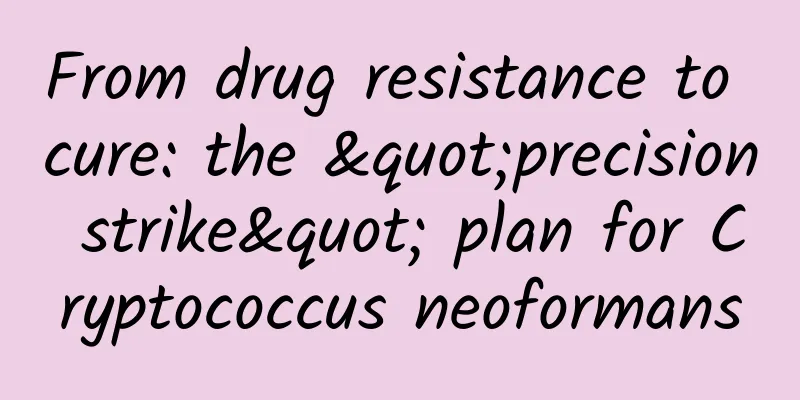From drug resistance to cure: the "precision strike" plan for Cryptococcus neoformans

|
Produced by: Science Popularization China Author: Yang Changjialian Chen Lei (Institute of Microbiology, Chinese Academy of Sciences) Producer: China Science Expo Editor's note: In order to decode the latest mysteries of life science, the China Science Popularization Frontier Science Project has launched a series of articles called "New Knowledge of Life" to interpret life phenomena and reveal biological mysteries from a unique perspective. Let us delve into the world of life and explore infinite possibilities. On average, seven people in the world lose their lives every minute due to fungal infections. Failure of antifungal drug treatment and recurrent infections often occur in clinical practice, resulting in a high mortality rate. Among them, fungal meningitis is the most deadly. Its etiology is complex, with a mortality rate of more than 40%, which seriously threatens patients with weakened immunity and the elderly. The "culprit" that causes fungal meningitis is Cryptococcus neoformans, which causes about 180,000 deaths worldwide each year and has become a major challenge to public health. Wang Linqi's team from the Institute of Microbiology, Chinese Academy of Sciences, published important research results in an international authoritative journal, discovering that brain glucose can induce Cryptococcus neoformans to develop resistance to amphotericin B. The team has found a potential therapeutic breakthrough, providing new hope for the treatment of fungal meningitis. What exactly is fungal meningitis and how is it caused? Cryptococcus neoformans and fungal meningitis Cryptococcus neoformans is the main pathogen causing fungal meningitis, which is particularly deadly to people with impaired immune function, such as AIDS patients, transplant patients and the elderly. This fungus has strong adaptability and can penetrate the blood-brain barrier, enter the brain tissue, and affect the patient's nervous system by causing chronic meningitis. Once infected, patients often face long-term treatment, recurrence of the disease and a higher risk of death. The only fungicidal drug currently available for the treatment of cryptococcal meningitis is amphotericin B. In vitro, this drug has excellent killing activity against cryptococci, but in clinical practice, treatment failure and recurrent infection of cryptococcal meningitis frequently occur. This has been a problem that has plagued scientists and doctors. It wasn't until 2024 that Wang Linqi's team at the Institute of Microbiology, Chinese Academy of Sciences, discovered that brain glucose can induce Cryptococcus neoformans to develop resistance to amphotericin B! The team also conducted further research and found a potential breakthrough in treatment. Glucose tug-of-war in the brain In the past, we always thought that drug resistance was more caused by genetic mutations in the fungi themselves, but the research of Wang Linqi's team revealed a completely new perspective - host-induced antifungal tolerance, which is mediated by metabolically active fungal cells and depends on the induction of specific host factors. Phenotypic resistance has nothing to do with genetic mutations, but is stimulated by changes in conditions or the environment. In the past 20 years, scientists have confirmed the existence of fungal phenotypic resistance under in vitro conditions, but have not found key evidence for the existence of fungal phenotypic resistance in vivo. The research team systematically screened about 340 metabolites and found that glucose is a key factor affecting the phenotypic resistance of Cryptococcus neoformans to amphotericin B in human cerebrospinal fluid samples (the main colonization site of Cryptococcus neoformans in the brain). Amphotericin B kills fungi by binding to ergosterol in the fungal cell membrane, thereby destroying the cell membrane. However, the glucose concentration in the cerebrospinal fluid can induce the transcription factor Mig1 protein of Cryptococcus neoformans to enter the cell nucleus, thereby prompting the fungus to produce more inositol phosphorylated ceramide (IPC), a molecule that can "compete" with ergosterol for amphotericin B. This is like a tug-of-war game, with ergosterol and IPC pulling at both ends of amphotericin B, and IPC pulling more forcefully, causing amphotericin B's ability to bind to its target to be greatly weakened. This also explains why in some patients, even without fungal gene mutations, the treatment effect is still not ideal. It turns out that changes in the host environment, such as the concentration of glucose, are quietly changing the therapeutic effect of the drug. Schematic diagram of the glucose-induced Am B tolerance model in cryptococcal meningitis (Image source: Reference 1) New strategy to overcome fungal drug resistance Since glucose is an important cause of drug resistance, could focusing on blocking this mechanism help improve the therapeutic effects of drugs? The answer is yes. The research team found a drug called Aureobasidin A (AbA), which can inhibit the synthesis of IPC enzymes. In other words, Aureobasidin A can work together with amphotericin B to weaken the "power" of IPC to compete for ergosterol, thereby eliminating glucose-induced fungal phenotypic resistance. When aureobasidin A and amphotericin B were used together, amazing results appeared. In the mouse meningitis model, compared with the traditional amphotericin B and flucytosine combination therapy, this new regimen not only significantly improved the cure rate, but also completely eliminated cryptococci in the brain in 70% of mice. Although this treatment regimen still needs further clinical trials, it undoubtedly brings new hope for the future treatment of fungal meningitis. The drug resistance of Cryptococcus neoformans has become a thorny problem for the global medical system, and the World Health Organization has therefore listed it as one of the highest levels of the "List of Priority Fungal Pathogens". The emergence of aureobasidin A has brought new hope for antifungal drug treatment . More importantly, its target only exists in fungal cells and will not affect human cells, so it is very safe. Although the drug is currently only effective against a few fungi, studies have demonstrated its potential in treating cryptococcal infections. More clinical trials will be needed in the future to verify its safety and effectiveness and further expand its scope of application. Let's work together to protect our health Fungal research started late globally, and many basic problems have not yet been solved. With global warming, the increase in the number of immunocompromised people, and the abuse of antibiotics, the risk of fungal infections is increasing year by year. To truly overcome this problem, it requires not only the efforts of scientific researchers, but also the attention and understanding of the public. Perhaps some little knowledge you accidentally learned in your daily life, such as "diabetic patients should control blood sugar to prevent recurrence of fungal infections", may become a protective shield for your healthy life. References: 1. Chen, L. Brain glucose induces tolerance of Cryptococcus neoformans to amphotericin B during meningitis. Nature Microbiology 9, (2024). |
<<: I heard that marble has radiation? The mineral that can really harm you is...
>>: H1N1 flu is coming, understand these symptoms and don't panic
Recommend
What causes vaginal swelling and itching?
Vaginal redness, swelling and itching have become...
Normal gestational sac size at 50 days of pregnancy
We understand that the key to the gestational sac...
Is uterine prolapse easy to treat? What are the precautions for treatment?
The uterus is a very important organ for women. I...
What medicine should pregnant women take for iron deficiency anemia
Iron deficiency anemia is a very common disease. ...
How is a typhoon considered to have made landfall? Direction of rotation of a typhoon
my country divides tropical cyclones in the South...
What does vaginal discharge look like during pregnancy
Under normal circumstances, women do not have any...
How to take photos of buildings and the big moon How to take photos of the super big moon
The supermoon is a very special astronomical phen...
How to treat sudden inverted nipples?
A woman’s breast health is related to all aspects...
Can pregnant women use skin care products?
Loving beauty is every woman’s nature, but basica...
Pain on both sides of lower back in women
Women's bodies are relatively weaker, which m...
What are the small bumps on the female vulva?
Many women think that it must be a gynecological ...
What is the reason for leucorrhea like tofu dregs
Leucorrhea can be regarded as the main secretion ...
Postpartum pubic separation rehabilitation training
Pregnancy is a huge thing for all women, because ...
If I can't detect a strong positive result, will I ovulate?
When couples are preparing for pregnancy, they pa...
What are the effects of vasectomy on women?
There are many ways to prevent pregnancy. If you ...









